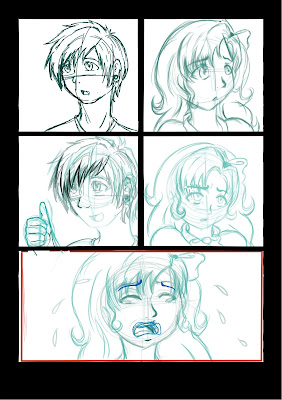 |
| Page 1 |
 |
| Page 2 |
 |
| Page 3 |
 |
| Page 4 |
 |
| Page 5 |
 |
| Page 8 |
 |
| Page 7 |
 |
| Page 8 |
~ ~ ~ ~ ~ ~ ~ ~ ~ ~ ~ ~ ~ ~ ~ ~ ~ ~ ~ ~ ~ ~
The last thing before the zine was finished was to make the cover! I wanted something simple and mostly dark, to fit the tone of the zine. My best idea was to have the ghost girl appear behind Joey and have them fade into black, so I used the blur tools to blend the cover into black.
I decided to go with the name "Lost & Found" as it was a simple title that became clear what it means when looking through the zine, The lost bear being found again being the main plot point. The text was written with my tablet for ease, copied and faded out to allow it to stand out and look quite old fashioned but contemporary as well. Adding the bow into the back cover broke up the blank space of the backing, but also seemed a cute way to end the whole zine with as that too is the final panel.
As a final little touch, I also wanted to add a break between the cover and start of the zine, So I made a repeat pattern with the two most meaningful images in the zine, the teddy bear and the bow.

 It felt like a cute extra to make the zine different and not just start straight away, but also becomes more meaningful after reading, because you then understand why a bear and a bow was used.
It felt like a cute extra to make the zine different and not just start straight away, but also becomes more meaningful after reading, because you then understand why a bear and a bow was used. I did two versions, one with the text and one without, because I wanted to see if one with text would look more professional, although in the end I liked the simplistic use of just the repeat pattern to start with. A thought that did cross my mind was what if I used the version with the text as a cover itself? As it reminded me of repeat pattern Penguin Classics books that have been made. If I was to do this project again, it might be a nice idea to do two different covers, one printed simply on card and another as a special edition that could be on cloth, hard board or even clear acetate.
~ ~ ~ ~ ~ ~ ~ ~ ~ ~ ~ ~ ~ ~ ~ ~ ~
PRINTED & STITCHED ~
I used a thicker paper for the cover, 150gsm, just so it's sturdy enough to stand up if need be, but also have a more professional finish of having a tougher cover and thinner, normal pages.
The inner cover (Bears and Bows pattern) was printed onto 100gsm glitter woven paper, that had a slightly rough texture to it, this seemed much more unique to use as a inner cover and to break up the types of paper.


Evaluation
This has been the first time I have drawn any kind of comic, so I was really pleased with the fact I managed to get one made and even printed out! I think I did really well in learning how to use digital tools to create the effects I wanted, piecing it together and creating something different.
It's something I was certainly really like to do again in the future, however I know that I would want more time to fully plan out and try a few different things. Having to figure out what kind of backgrounds go well against characters was something new, and I do believe this has been ever-so-slightly too dark (or at least just in the backgrounds) so I'd want to work on getting more tests with landscapes and backgrounds, even though it might not be my favourate part of comics/zines to do.
Printing out the zine ended up being stressful too, as when printed, alot of the pages were almost too dark to see, so there was alot of readjusting the brightness and saturation to try and get it to come out clear. I think my final version was still just a bit too dark, but at least I know now that when working digitally, I will have to brighten up darker themed works before taking them to print! On the other hand, thinking differently, If I was to publish this as a digital comic, I think it would be OK.
All in all, I did enjoy finally doing something I've wanted to do for so long, and I am quite pleased with the outcome. I would have liked to have re-done a few panels that I personally don't think are the strongest, and I still need to keep practicing proportion, but I know that I'm a step closer to doing what I've always hope to do, more comics!









































